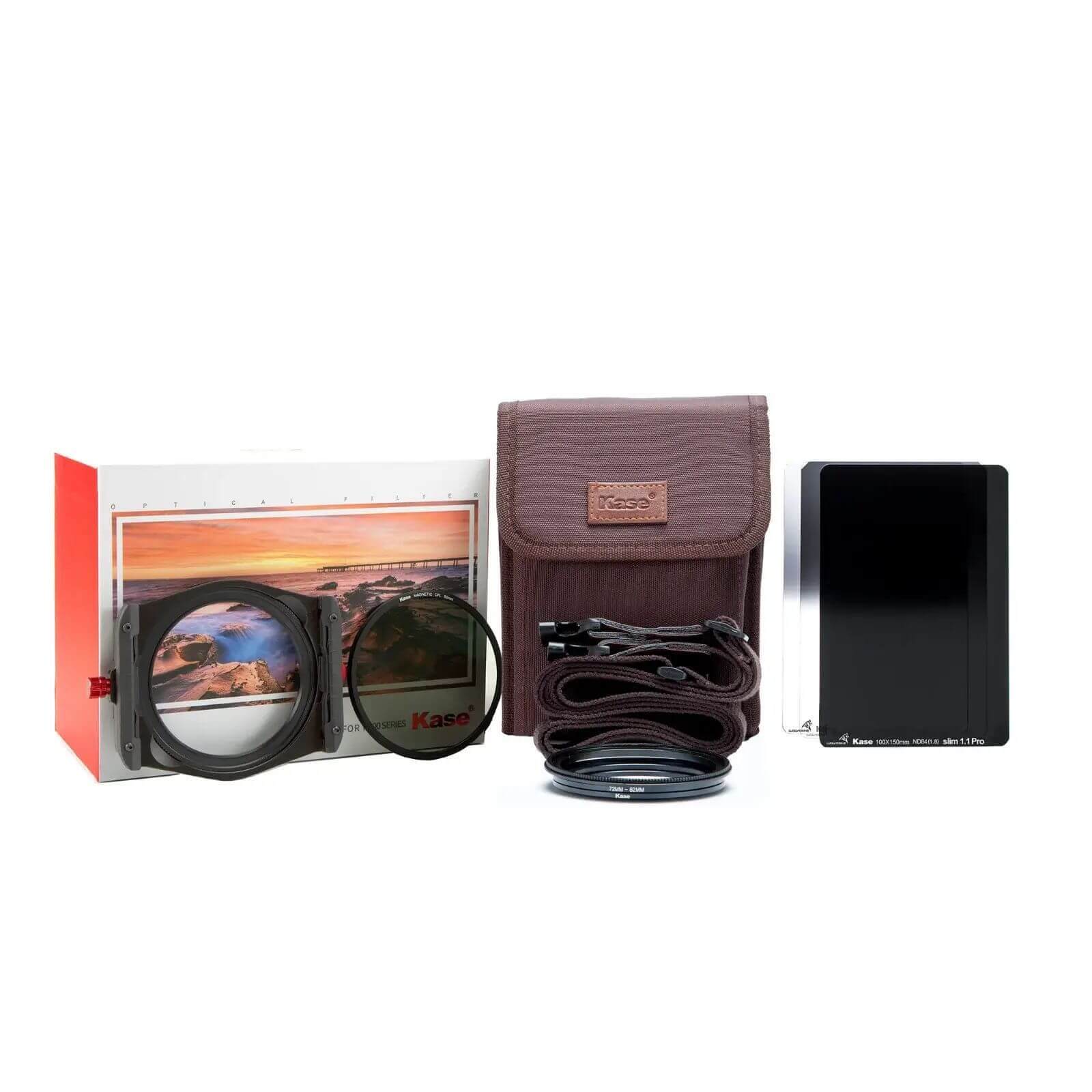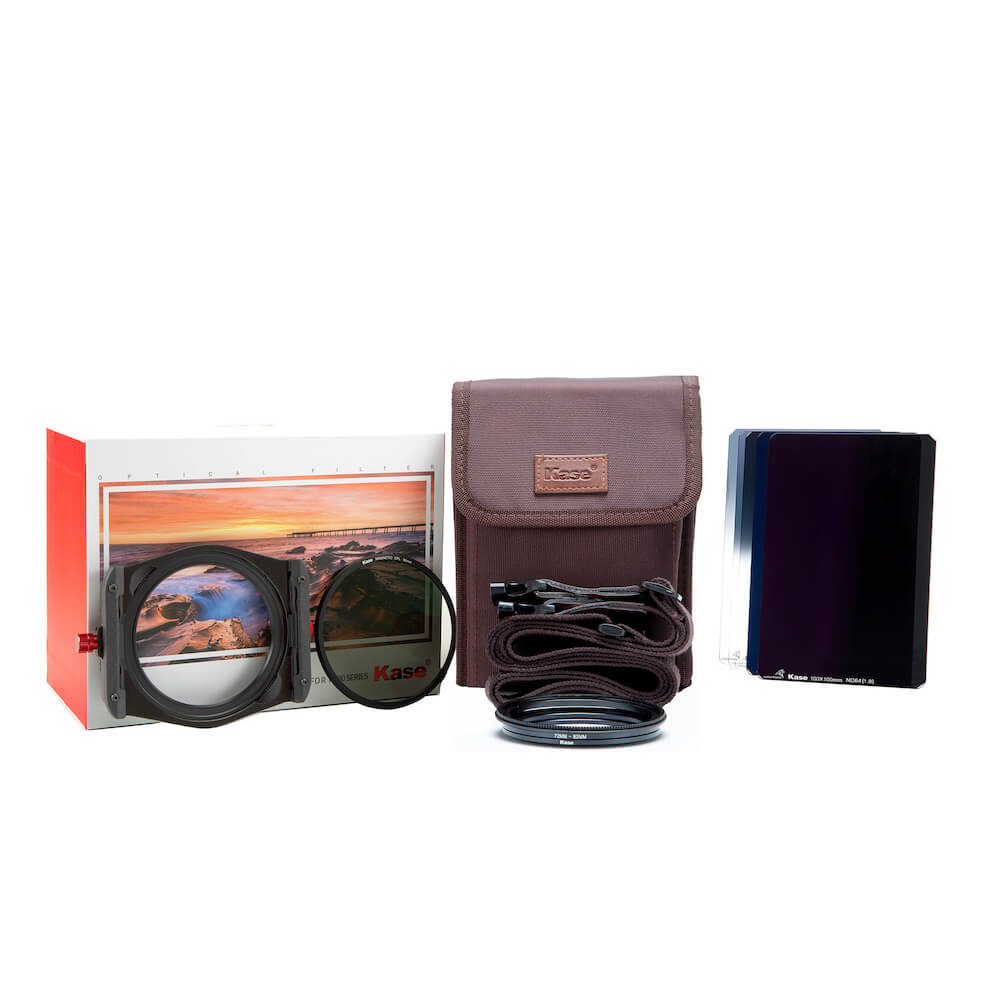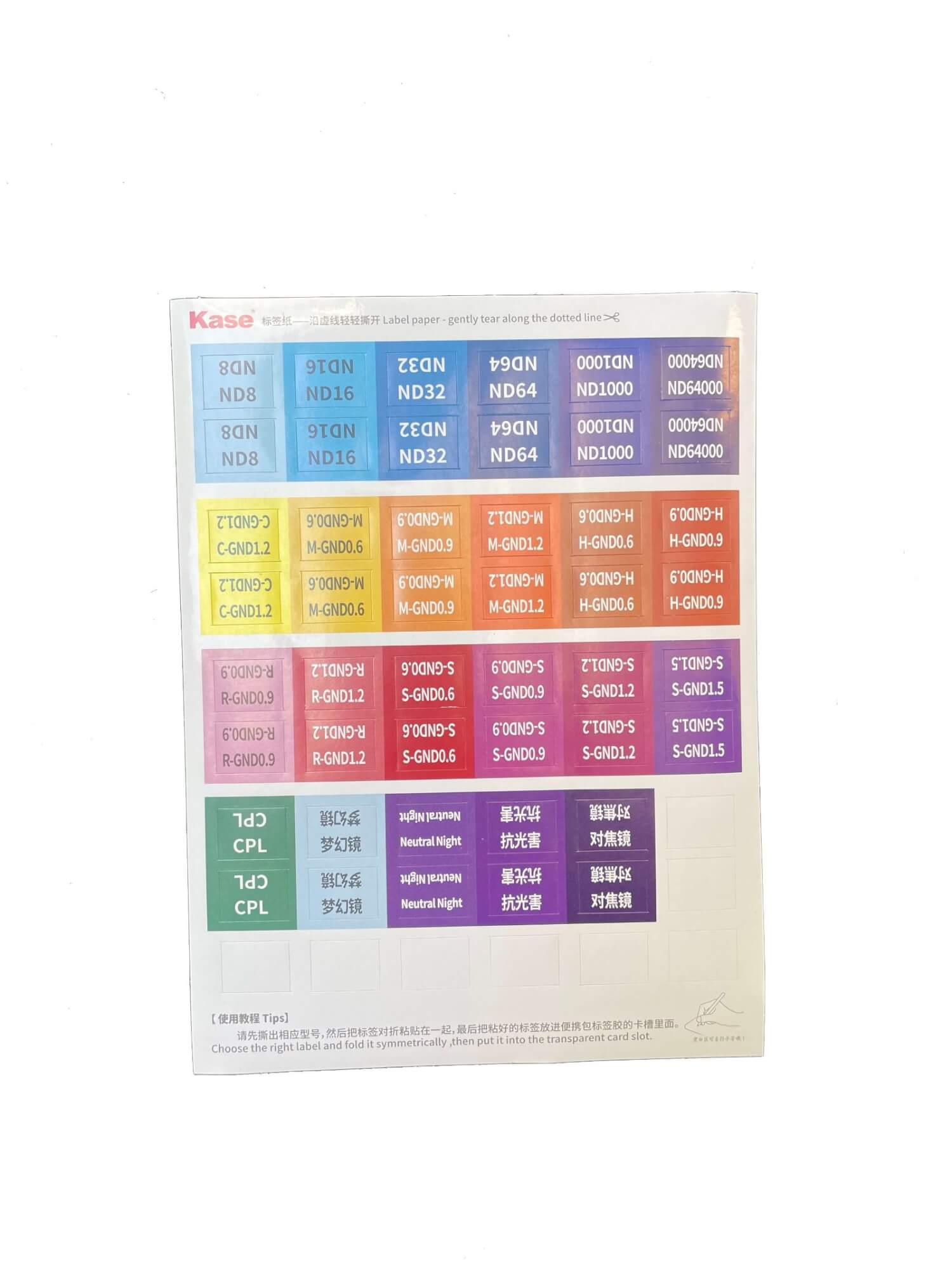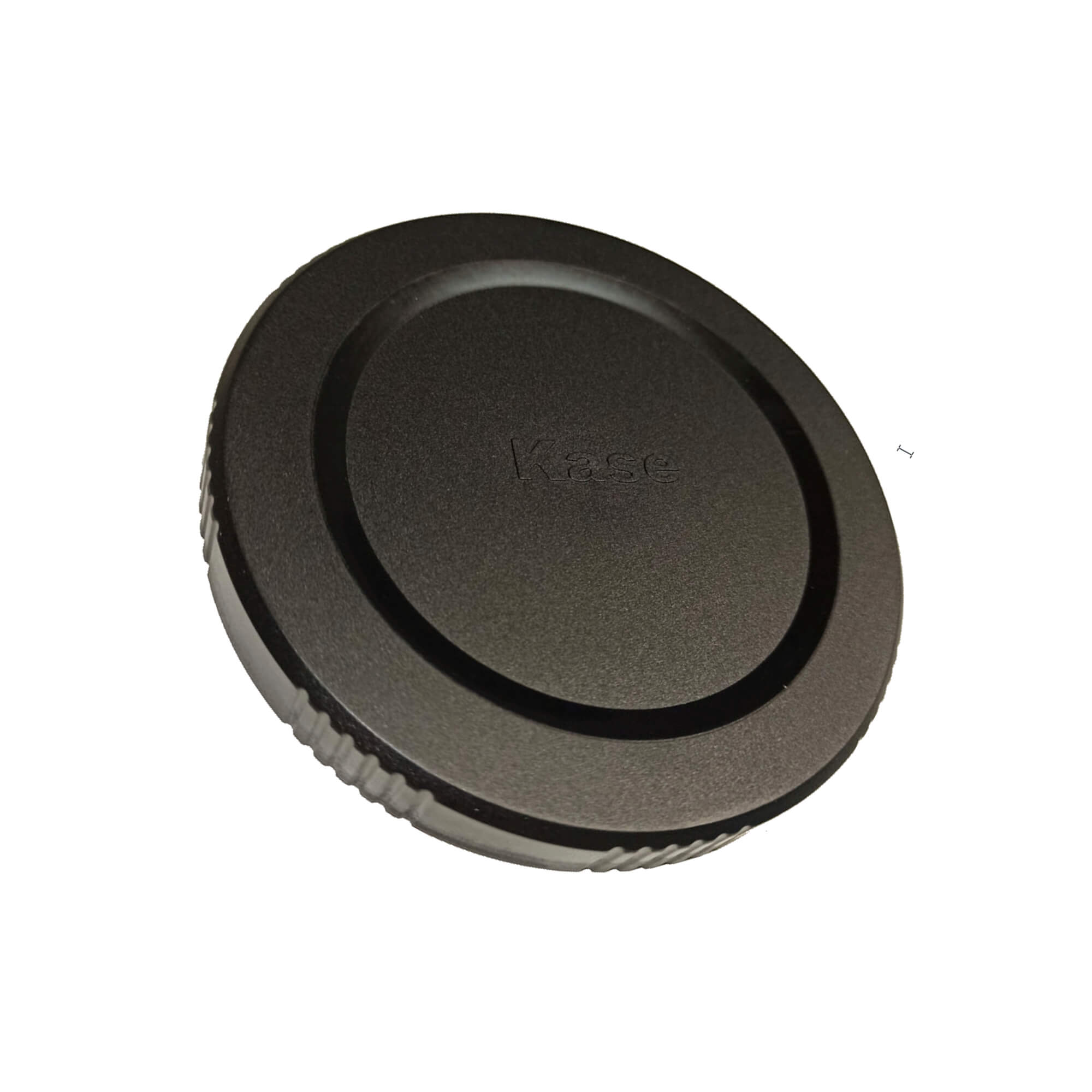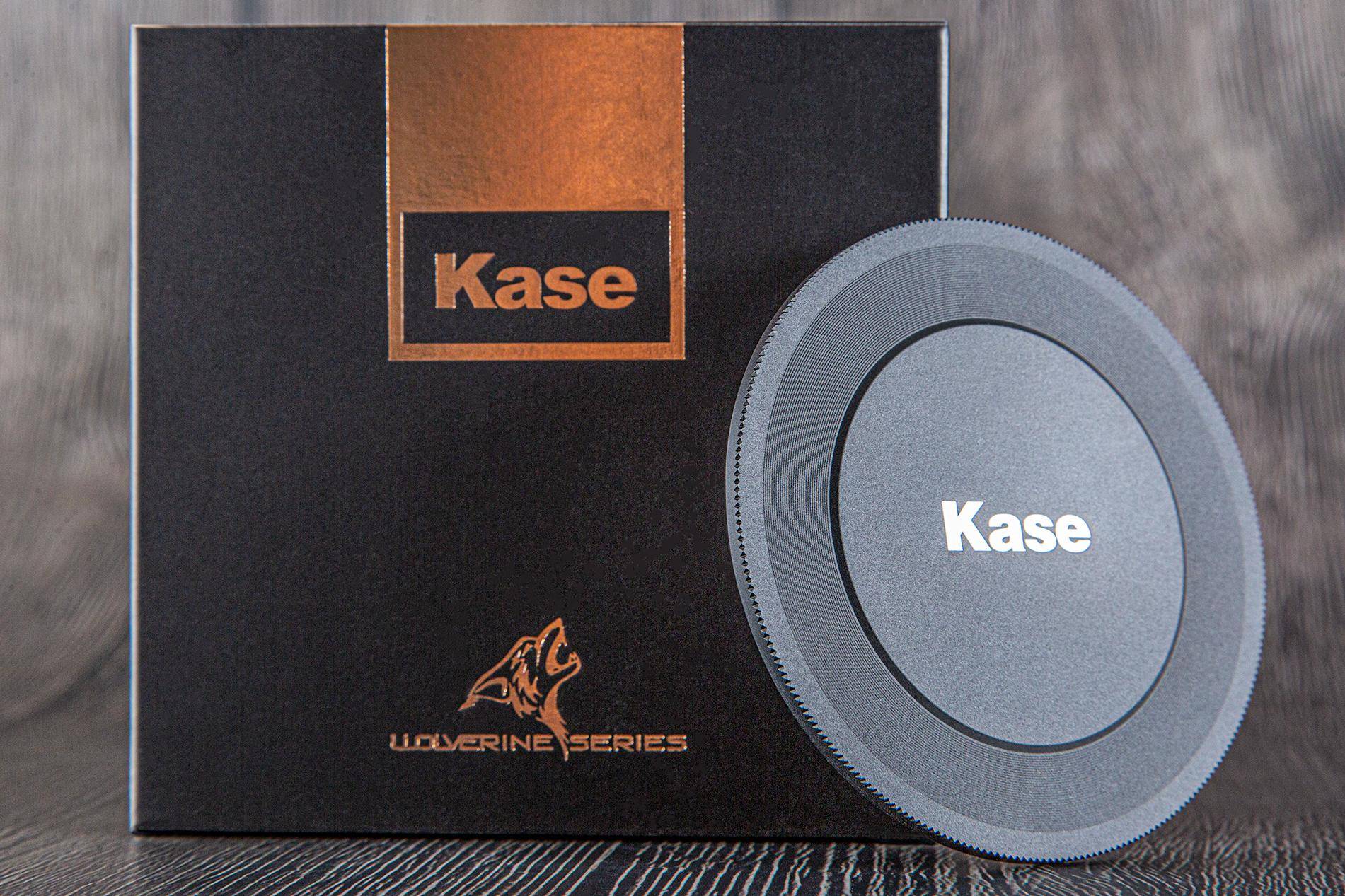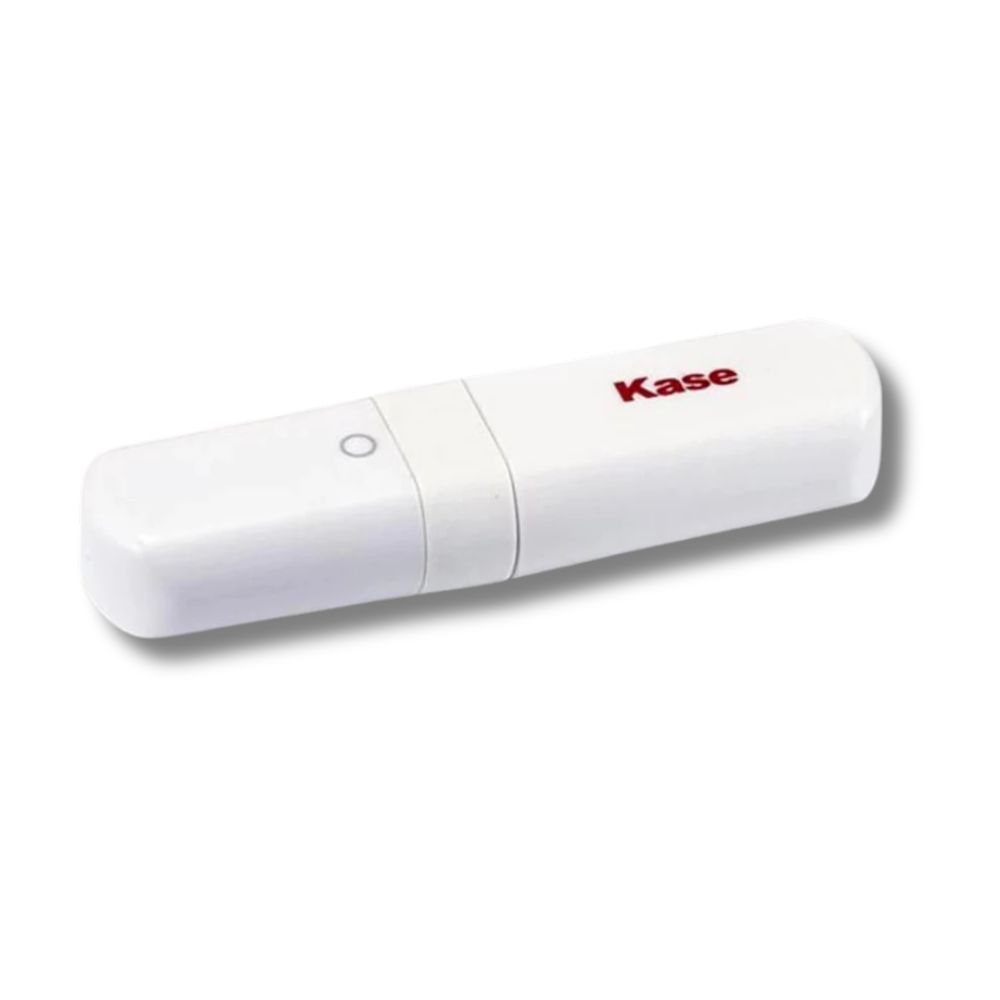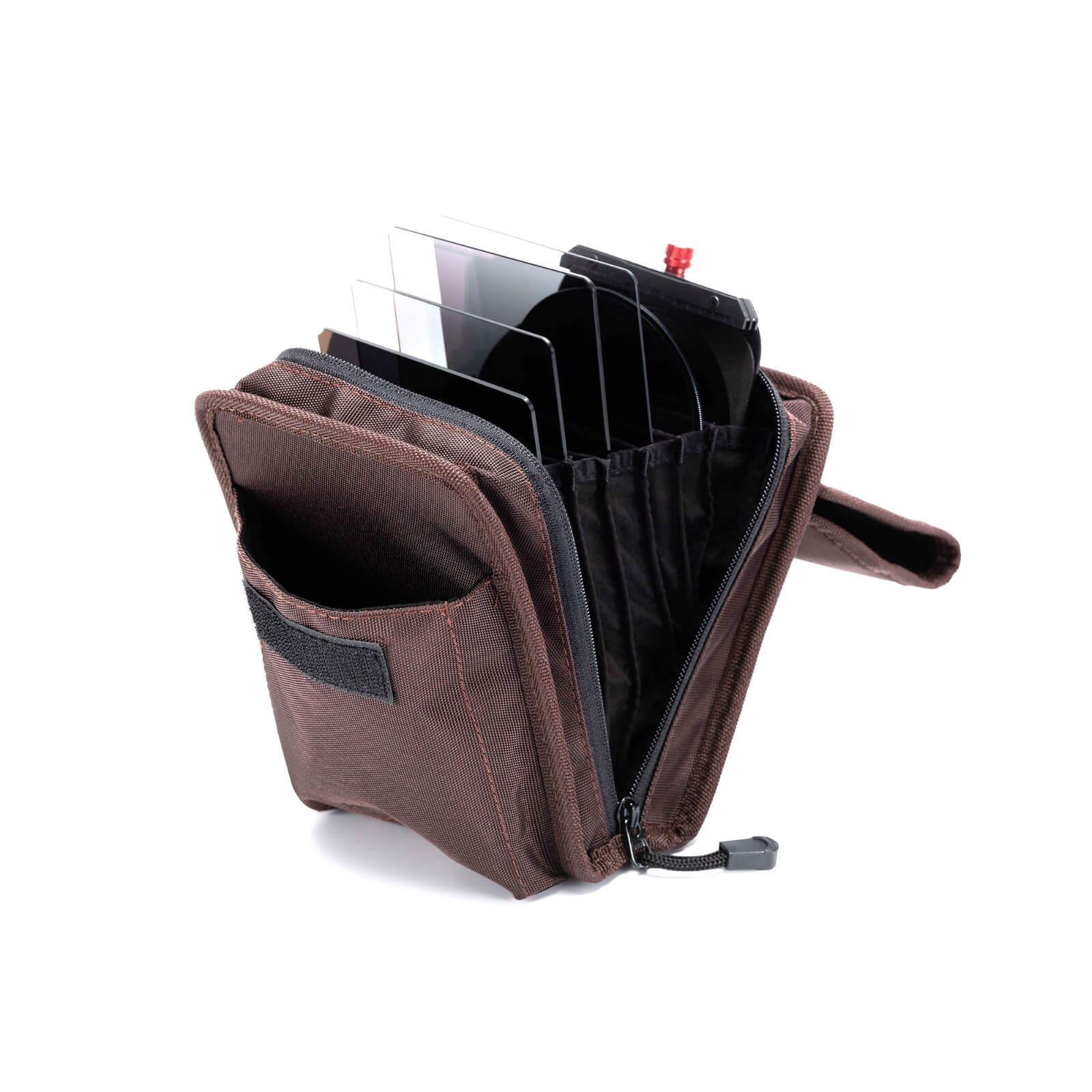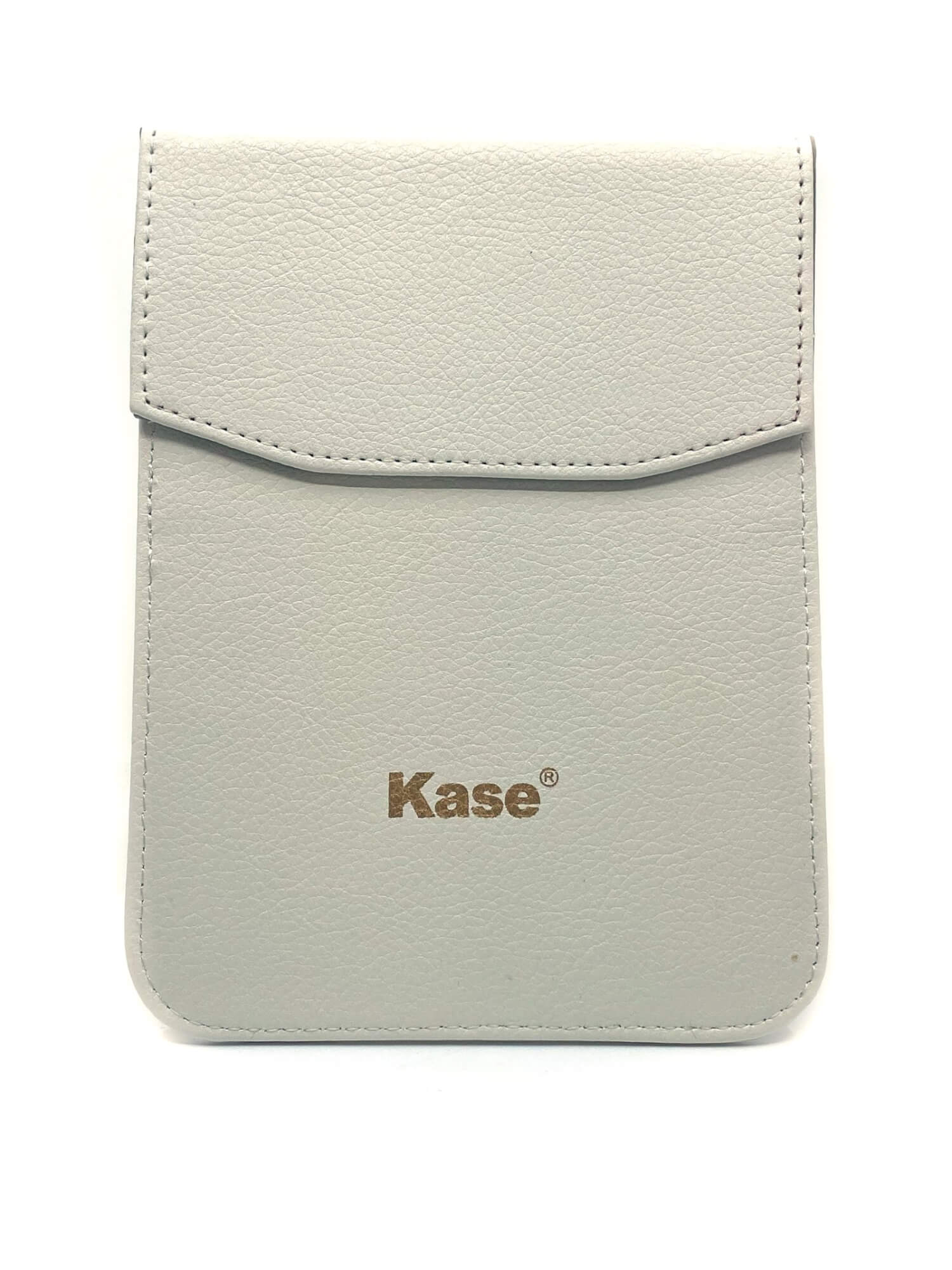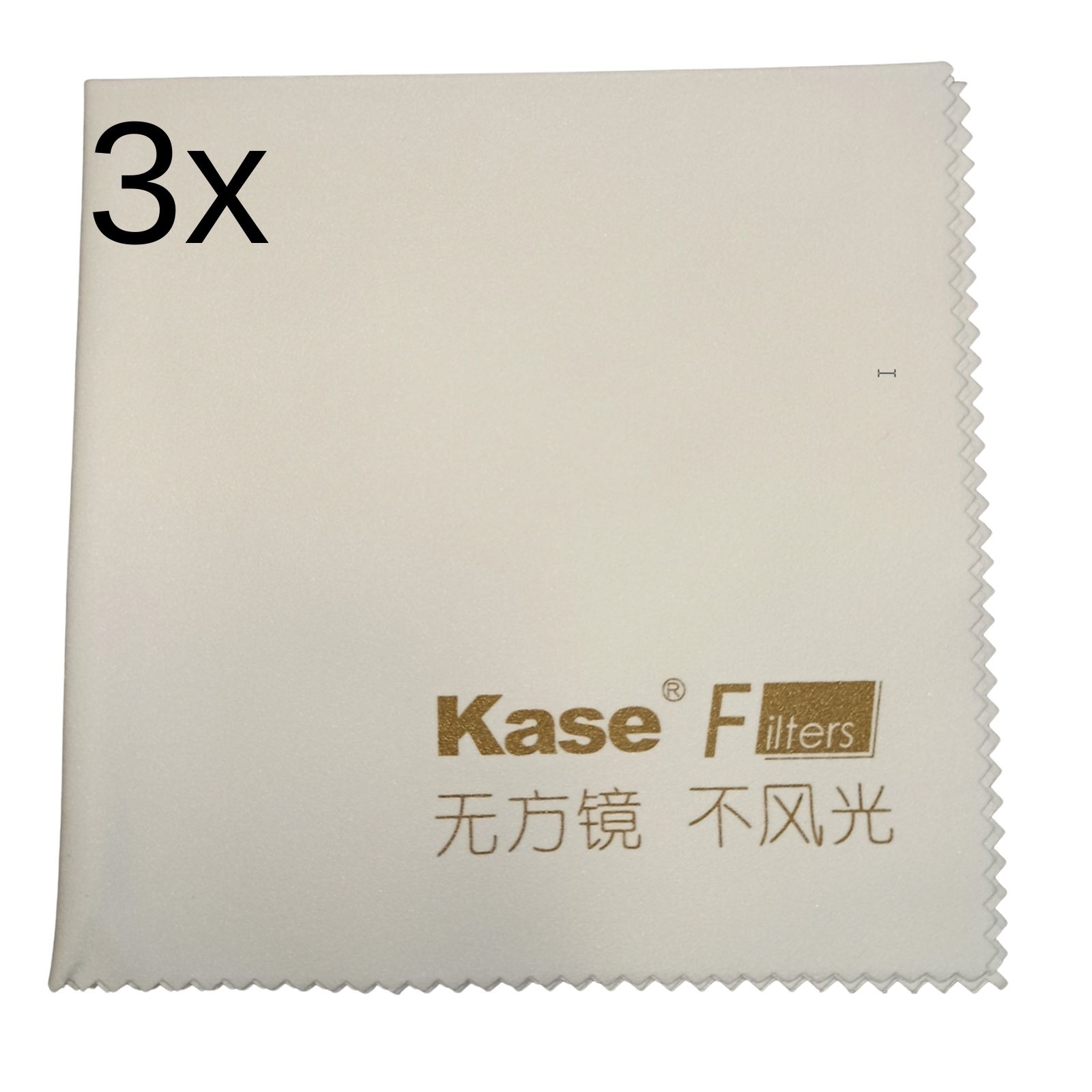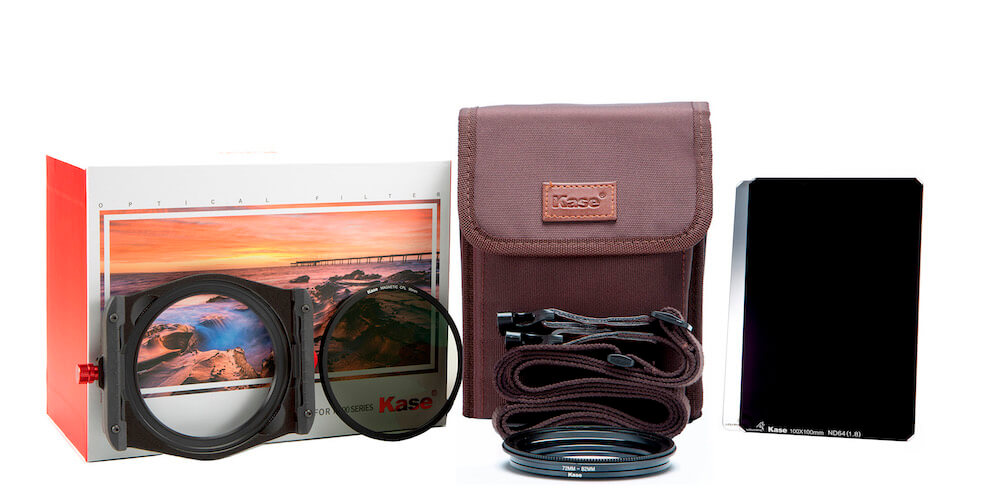
Il kit di ingresso della serie Wolverine di Kase è il set di ingresso nel mondo dei filtri rettangolari K100 (100x100 o 100x150 mm) di Kase. Il kit è composto dal nostro innovativo portafiltro K9 con un filtro polarizzatore magnetico da 90 mm (circolare), 2 anelli adattatori e 2 anelli step-down, nonché un filtro GND (filtro graduato grigio) da 100x150 mm e un filtro ND Wolverine (filtro grigio). Contenuto della fornitura: 1x kit portafiltro K9 2x anelli adattatori (77mm-90mm e 82-90mm) per filtri a polarizzazione magnetica 2x anelli di riduzione (67mm-82mm e 72mm-82mm) 1x filtro magnetico Slimline CPL (filtro polarizzatore) da 90 mm 1x filtro graduato Wolverine K100 (100x150 mm) Soft GND 0,9 (3 stop/3 stop) 1x filtro grigio Wolverine K100 (100x150mm) ND1000 (10 f-stop/10 stop) 1x sacchetto per filtri 100x100 e 100x150 mm
In magazzino
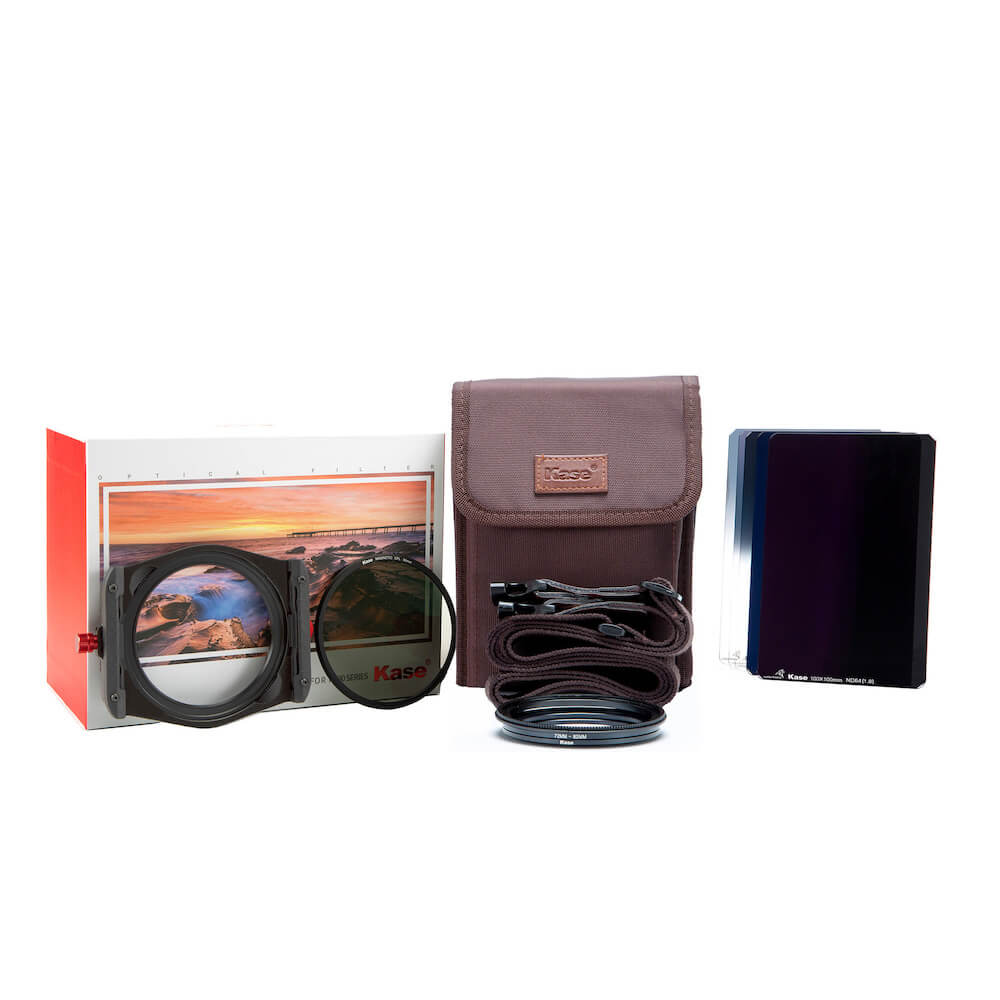
Il Kase Wolverine Master Set è il set di punta del mondo dei filtri K100 (100x150 mm rettangolari) di Kase. Il set è composto dal nostro collaudato portafiltro K100, da un filtro polarizzatore magnetico da 90 mm (circolare), da 2 anelli adattatori e da 2 anelli adattatori step-up, nonché da tre filtri GND (grigi graduati) da 100x150 mm e da due filtri ND Wolverine (grigi). Contenuto della fornitura: 1x set di portafiltri K9 2x anelli adattatori di base (77mm-90mm e 82-90mm) 2x anelli adattatori step-up a vite (67mm-82mm e 72mm-82mm) 1x filtro polarizzatore magnetico da 90 mm 1x filtro grigio Wolverine K100 100x150mm ND64 6 stop 1x Wolverine K100 100x100mm ND1000 10 stop filtro grigio1x Wolverine K100 100x150mm Soft GND 0,9 stop filtro graduato1x Wolverine K100 100x150mm Soft GND 1,2 stop filtro graduato1x Wolverine K100 100x150mm Filtro graduato inverso GND 0,9 stop1x K100 Soft filter bag per filtri 100x100mm e 100x150mm 1x panno in microfibra
In magazzino

La perfetta introduzione al mondo della fotografia creativa con filtro Il Kase Wolverine Series Entry-Level Kit 1 è il set di filtri rettangolari ideale per i fotografi di paesaggio più ambiziosi. Si rivolge a tutti coloro che desiderano portare i propri scatti a un livello superiore con un'esposizione controllata, dettagli del cielo più intensi e riflessi ridotti. Il set comprende l'innovativo portafiltro K9, un filtro polarizzatore CPL magnetico da 90 mm e filtri GND e ND di alta qualità della robusta serie Wolverine. Che si tratti di lunghe esposizioni alla luce del giorno, di tramonti d'atmosfera o di scatti creativi di paesaggi, con questo kit avrete a portata di mano lo strumento ideale. Grazie all'intelligente adattatore step-down, è compatibile con un'ampia gamma di obiettivi di dimensioni comuni (67-90 mm). Qualità robusta - libertà creativa I filtri sono realizzati in vetro ottico resistente ai graffi e neutro dal punto di vista cromatico della serie Wolverine, ideale per una qualità d'immagine brillante e priva di riflessi. Gli accessori in dotazione garantiscono la massima flessibilità e sicurezza di utilizzo. Caratteristiche e vantaggi in sintesi: ✅ S et completo per principianti nella fotografia con filtro rettangolare (100x150 mm) ✅ Filtro CPL magnetico da 90 mm: montaggio rapido, senza viti ✅ Filtro ND64 (6 stop): Per lunghe esposizioni in luce diurna ✅ Filtro Soft GND 0,9 (3 stop): Ideale per il controllo dell'esposizione di cielo e orizzonte ✅ Compatibilità universale: grazie agli adattatori step-down da 67 mm a 90 mm ✅ Borsa per filtri inclusa: trasporto sicuro dei filtri in viaggio 📦 Contenuto della fornitura: 1x kit portafiltro K9 2x anelli adattatori (77-90 mm e 82-90 mm) 2x anelli di riduzione (67-82 mm e 72-82 mm) 1x filtro polarizzatore magnetico CPL da 90 mm 1x Wolverine ND64 (100x150 mm, 6 stop) 1x Wolverine Soft GND 0,9 (100x150 mm, 3 stop) 1x borsa di trasporto per filtri 100x100 e 100x150 mm
In magazzino
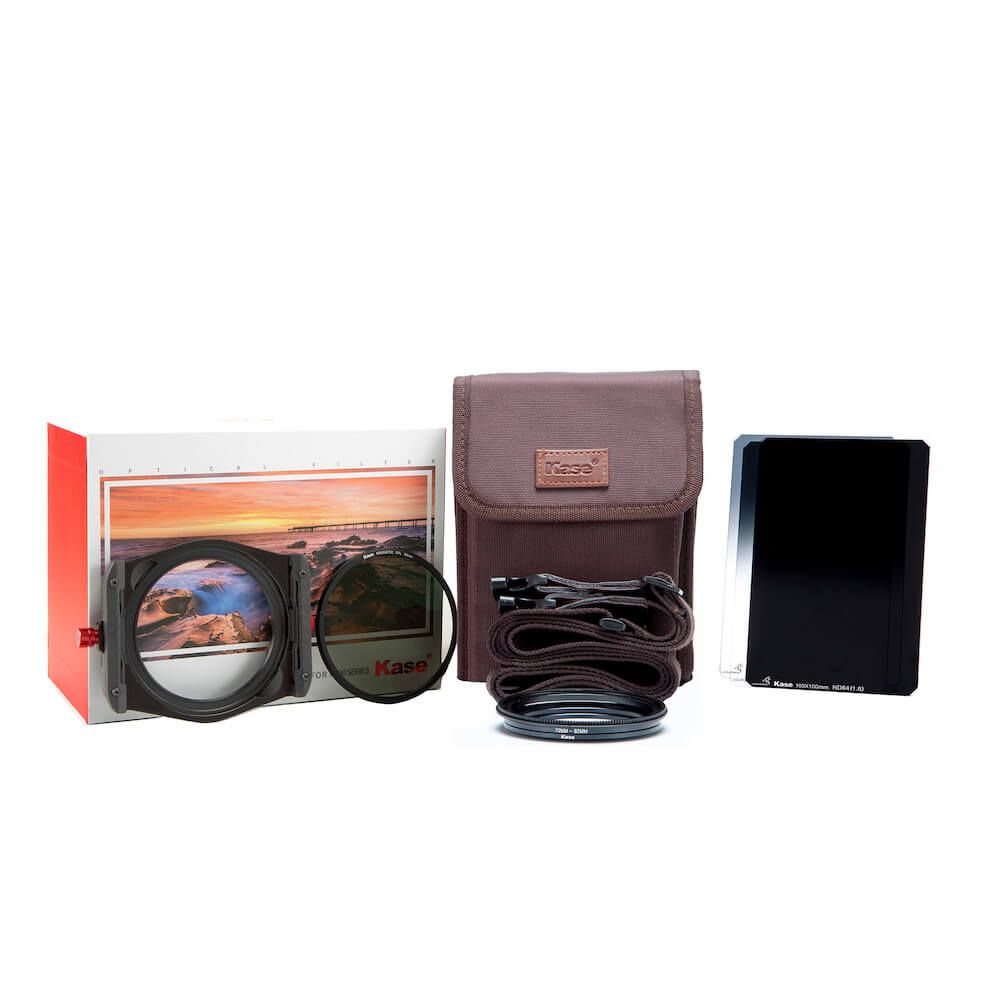
La perfetta introduzione al mondo della fotografia creativa con filtro Il Kase Wolverine Series Entry-Level Kit 1 è il set di filtri rettangolari ideale per i fotografi di paesaggio più ambiziosi. Si rivolge a tutti coloro che desiderano portare i propri scatti a un livello superiore con un'esposizione controllata, dettagli del cielo più intensi e riflessi ridotti. Il set comprende l'innovativo portafiltro K9, un filtro polarizzatore CPL magnetico da 90 mm e filtri GND e ND di alta qualità della robusta serie Wolverine. Che si tratti di lunghe esposizioni alla luce del giorno, di tramonti d'atmosfera o di scatti creativi di paesaggi, con questo kit avrete a portata di mano lo strumento ideale. Grazie all'intelligente adattatore step-down, è compatibile con un'ampia gamma di obiettivi di dimensioni comuni (67-90 mm). Qualità robusta - libertà creativa I filtri sono realizzati in vetro ottico resistente ai graffi e neutro dal punto di vista cromatico della serie Wolverine, ideale per una qualità d'immagine brillante e priva di riflessi. Gli accessori in dotazione garantiscono la massima flessibilità e sicurezza di utilizzo. Punti di forza e vantaggi in sintesi: ✅ S et completo per principianti nella fotografia con filtro rettangolare (100x150 mm) ✅ Filtro CPL magnetico da 90 mm: montaggio rapido, senza viti ✅ Filtro ND64 (6 stop): Per lunghe esposizioni in luce diurna ✅ Filtro Soft GND 0,9 (3 stop): Ideale per il controllo dell'esposizione di cielo e orizzonte ✅ Compatibilità universale: grazie agli adattatori step-down da 67 mm a 90 mm ✅ Borsa per filtri inclusa: trasporto sicuro dei filtri in viaggio 📦 Contenuto della fornitura: 1x kit portafiltro K9 2x anelli adattatori (77-90 mm e 82-90 mm) 2x anelli di riduzione (67-82 mm e 72-82 mm) 1x filtro polarizzatore magnetico CPL da 90 mm 1x Wolverine ND64 (100x150 mm, 6 stop) 1x Wolverine Soft GND 0,9 (100x150 mm, 3 stop) 1x borsa di trasporto per filtri 100x100 e 100x150 mm
In magazzino
Our K100 Filters Sets include these practical photography components
With our K100 filter kits we offer you an entry into the world of Kase filters. By purchasing our sets, you secure a price advantage compared to buying the products individually and you can start photography immediately. With the Kase Wolverine Series Entry-Level Kit, the perfect entry-level set into the K100 (100x150 mm) rectangular filter world from Kase. The filter set consists of our proven K100 holder with a magnetic 90mm polarizing filter (circular), 2 adapter rings and step-down rings each, as well as a SLIM Wolverine 100x150 mm gray gradient filter and a SLIM Wolverine 100x150 mm ND filter. Excellent landscape shots and long exposures can already be realized with this. But we also offer the "Kase Wolverine Soft K100 Master Kit 100x100 mm ND with K9 filter holder" for experienced photographers, for example. The Kase Wolverine Master Set is the top set of the K100 (100x100 mm or 100x150 mm) rectangular filter from Kase. The kit consists of our proven K100 filter holder, a magnetic 90mm polarizing filter (circular), 2 adapter rings and step-down rings each, as well as three 100x150 mm gray gradient filters and two Wolverine ND filters. Due to the large number of GND and ND filters in this set, you are prepared for every lighting situation and motif.
The versatile polarizing filter
The first important type of filter that you should not do without is the so-called polarization filter, which is also known as a polarizing filter and CPL filter. Polarizing filters make it possible to remove unwanted reflections from various surfaces such as glass, grass, water and leaves. In the case of meadows and trees, this ensures a more contrasting and richer landscape, as can be seen in the image below. With the optical glass, a polarizing filter makes the reflections almost completely disappear.
The effect is not always the same and depends on different factors. For example, the CPL filter can be rotated on the lens to change the intensity of the effect. The effect itself comes about because light waves oscillate in a certain direction. This direction is also known as the direction of polarization of the light. A polarizing filter is coated in such a way that it only allows light of a certain polarization to pass through. As a result, it swallows around 2 apertures of light, but at the same time reduces unwanted reflections.
A must in photography, the gray filter
A gray filter is screwed or placed in front of the lens to reduce the light hitting the camera sensor. This principle can be compared to that of sunglasses for the human eye. The effect allows longer exposure times to be achieved and many interesting shots to be taken. A gray filter can be used to achieve different design effects, such as people disappearing from busy squares. As a rule of thumb, the darker the gray filter, the stronger the effect in the photograph. Some effects that can be realized with an ND filter are listed below:
- Architectural shots (make moving people disappear)
- Wipe effects (make waterfalls, rivers and waves look silky)
- Solid light trails (moving cars)
In what strength should one choose ND filters?
For this purpose, we have created a table that shows which ND filter should be used in which situation. Below is a list of which filter has which neutral density, increases the shutter speed and darkens by how many stops. Read more about how to choose the right filter size on our article.
| Neutraldichte | Blendenstufen | Verlängerungsfaktor Verschlusszeit | Filterbezeichnung |
| 0,6 0,9 1,2 1,5 1,8 3,0 | 2 3 4 5 6 10 | 4x 8x 16x 32x 64x 1000x | ND4 ND8 ND16 ND32 ND64 ND1000 |


